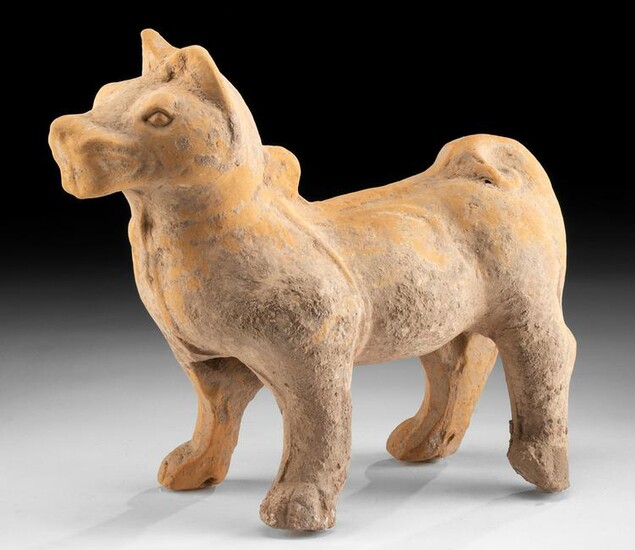Chinese Han Dynasty Pottery Dog w/ TL Test
East Asia, China, Han Dynasty, ca. 500 BCE to 300 CE. An alert dog with a strong, protective stance and a fierce disposition, mold-made from baked terracotta. His sturdy legs support his barrel-shaped body that has a circular vent on the underside. He has a tense energy, with a curved tail that lays against his haunches, a prominent, arched spine, and a snarling jaw, all painted a warm hue of coral. A pair of perky ears caps his head, sitting above a round snout and incised, almond-shaped eyes, as a leash wraps around his thick neck. Note the artist's impressive attention to detail, as evident in his carefully delineated toes. This guardian pup most likely belonged to an elite individual worthy of such devout protection! Size: 10.25" L x 4.25" W x 9.875" H (26 cm x 10.8 cm x 25.1 cm)
Han Dynasty sculptors recreated various breeds of dogs in their artwork, and this example is a chow dog, who are often shown with harnesses and collars because they were used to pull small sleighs. During the Han Dynasty, such ceramic dog statues were used as tomb guardians to protect the master's grave. All Han Dynasty pottery dogs were formed by two-part molds. Once the main form was attained, details such as eyebrows and whiskers were added. We see more dogs appearing in the later Han period, frequently in tombs. This is most likely because during this period the landed gentry lived on large estates and needed dogs to keep guard. The dog also makes an appearance on jade carvings of hounds during the Han Dynasty; hence, dogs apparently were cherished as a status symbol.
This piece has been tested using thermoluminescence (TL) analysis and has been found to be ancient and of the period stated. A full report will accompany purchase.
Provenance: private Masontown, Pennsylvania, USA collection; ex-Golden Triangle Antiques, Chicago, Illinois, USA, acquired on September 12th, 2000
All items legal to buy/sell under U.S. Statute covering cultural patrimony Code 2600, CHAPTER 14, and are guaranteed to be as described or your money back.
A Certificate of Authenticity will accompany all winning bids.
We ship worldwide to most countries and handle all shipping in-house for your convenience.
#163605
Condition Report: TL holes on front paw and belly by back proper left leg. Felt pads on bottom of each paw. Loss to tip of proper left ear. Expected nicks, abrasions, and pitting, commensurate with age. Otherwise, excellent with impressive remaining pigments and lovely earthen deposits throughout.
View it on
Estimate
Time, Location
Auction House
East Asia, China, Han Dynasty, ca. 500 BCE to 300 CE. An alert dog with a strong, protective stance and a fierce disposition, mold-made from baked terracotta. His sturdy legs support his barrel-shaped body that has a circular vent on the underside. He has a tense energy, with a curved tail that lays against his haunches, a prominent, arched spine, and a snarling jaw, all painted a warm hue of coral. A pair of perky ears caps his head, sitting above a round snout and incised, almond-shaped eyes, as a leash wraps around his thick neck. Note the artist's impressive attention to detail, as evident in his carefully delineated toes. This guardian pup most likely belonged to an elite individual worthy of such devout protection! Size: 10.25" L x 4.25" W x 9.875" H (26 cm x 10.8 cm x 25.1 cm)
Han Dynasty sculptors recreated various breeds of dogs in their artwork, and this example is a chow dog, who are often shown with harnesses and collars because they were used to pull small sleighs. During the Han Dynasty, such ceramic dog statues were used as tomb guardians to protect the master's grave. All Han Dynasty pottery dogs were formed by two-part molds. Once the main form was attained, details such as eyebrows and whiskers were added. We see more dogs appearing in the later Han period, frequently in tombs. This is most likely because during this period the landed gentry lived on large estates and needed dogs to keep guard. The dog also makes an appearance on jade carvings of hounds during the Han Dynasty; hence, dogs apparently were cherished as a status symbol.
This piece has been tested using thermoluminescence (TL) analysis and has been found to be ancient and of the period stated. A full report will accompany purchase.
Provenance: private Masontown, Pennsylvania, USA collection; ex-Golden Triangle Antiques, Chicago, Illinois, USA, acquired on September 12th, 2000
All items legal to buy/sell under U.S. Statute covering cultural patrimony Code 2600, CHAPTER 14, and are guaranteed to be as described or your money back.
A Certificate of Authenticity will accompany all winning bids.
We ship worldwide to most countries and handle all shipping in-house for your convenience.
#163605
Condition Report: TL holes on front paw and belly by back proper left leg. Felt pads on bottom of each paw. Loss to tip of proper left ear. Expected nicks, abrasions, and pitting, commensurate with age. Otherwise, excellent with impressive remaining pigments and lovely earthen deposits throughout.



